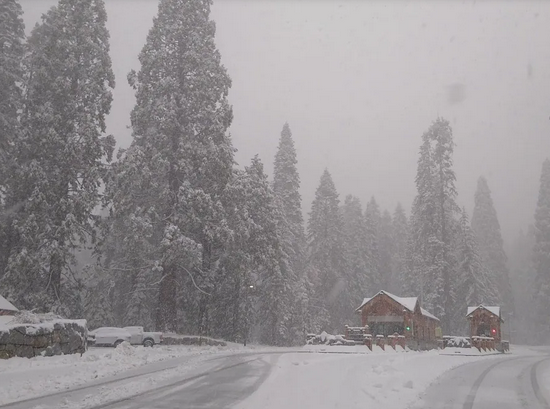A winter storm promises to wallop the Sierra Nevada with up to 10 feet of snow and deliver much-needed rain across the parched San Joaquin Valley floor.
Visalia, Tulare and Porterville may see up to 2 inches of rain, while the Sierra foothills are expected to receive twice that — up to 4 inches — beginning late Sunday, according to forecasters.
A Winter Storm Warning is in effect across the Sierra from 4 a.m. Monday to 10 p.m. Tuesday, with up to 4 feet of snow forecasted for Sequoia National Park and up to 6 feet predicted for areas of Yosemite National Park. Snow levels will begin at 6,000 feet elevation Monday before dropping as low as 3,500 feet Tuesday afternoon.
“Intense snowfall and strong winds will make travel difficult in the Sierra Nevada Monday and Tuesday,” the National Weather Service Hanford office said in a tweet Saturday.
North of Yosemite, the storm is expected to bring near-historic amounts of snow and precipitation.
“If you live in the Sierra, today is the final day to prepare for a multi-day winter storm that will likely be remembered for years to come,” the National Weather Service warned in a forecast issued Saturday.
Another storm system predicted to hit California midweek could deliver almost continuous snow, said Scott McGuire, a meteorologist with the weather service’s Reno office. Downed trees and white-out conditions could endanger motorists; meanwhile, the Sierra Avalanche Center warned heavy snow and strong winds on top of a weak snowpack could cause large and destructive avalanches.
“If you are traveling through the Sierra, either get ahead of the storm before snowfall begins or wait until it’s over to get up there. It will be increasingly treacherous,” he said.
A low-pressure system from the Pacific Northwest was on track to hit coastal areas north of San Francisco Saturday night and drop light rain. The heaviest rainfall was expected to come Sunday night into Monday morning as the storm spreads to the east and south, said Sarah McCorkle, a meteorologist with the weather service’s Bay Area office.
The amount of rain is typical for this time of year, McCorkle said, even though the last couple of years have been unusually dry. The storm should help relieve dry conditions, but won’t mark an end to the drought, according to the U.S. Drought Monitor.
The megadrought fueled by climate change has enveloped much of the West. As California heads into what traditionally is its wettest time of the year, 80% of the state is classified as in extreme or exceptional drought, the two worst categories.














